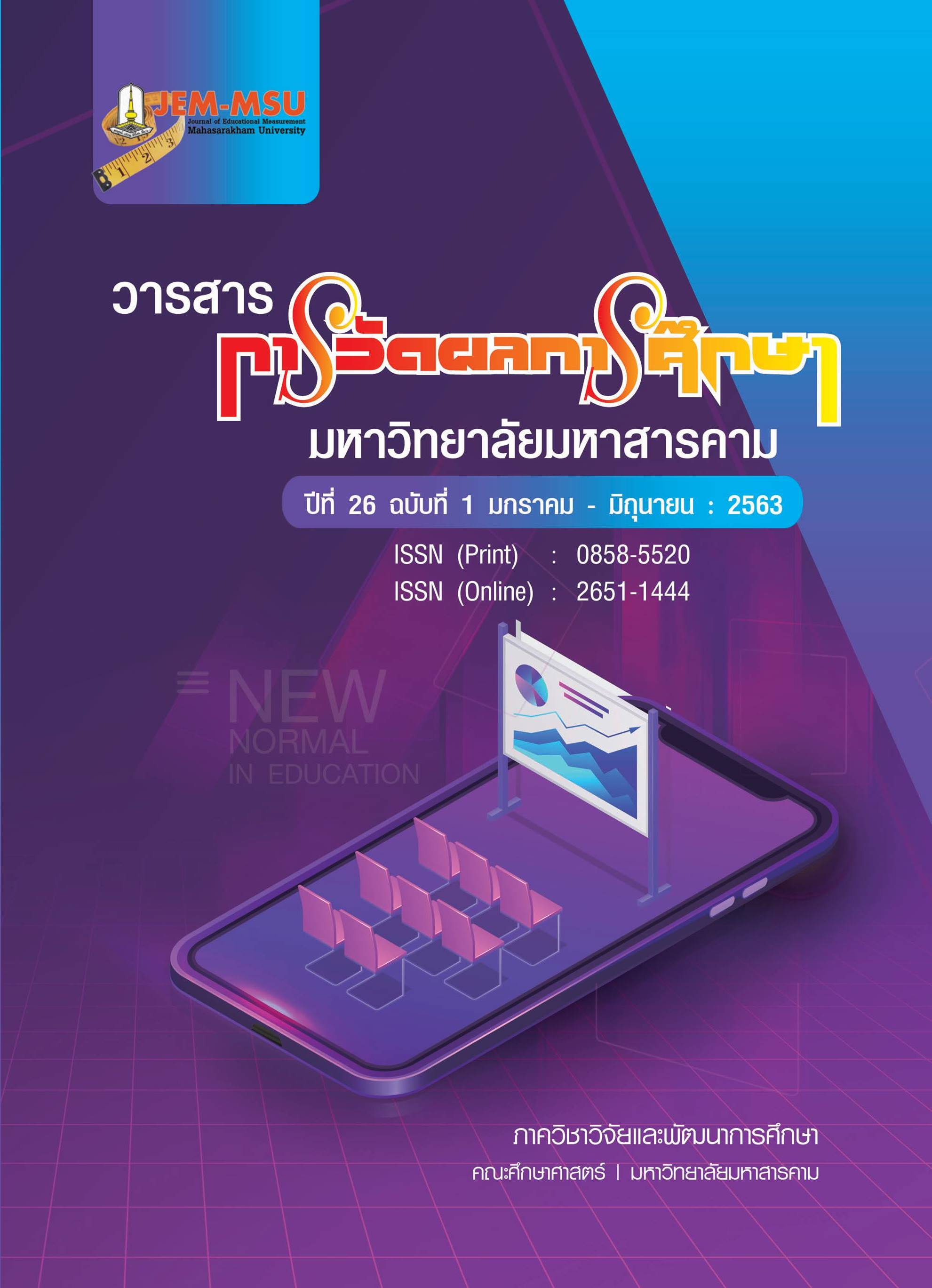Development of the Internal Supervision Process in Secondary Schools under the Secondary Educational Service Area Office 7 in the 21st Century
Main Article Content
Abstract
The purposes of this research were: to investigate the current conditions, problems, and needs for development of the internal supervision process in secondary schools under the Secondary Educational Service Area Office 7 in the 21st century; to develop the internal supervision process in secondary schools under the Secondary Educational Service Area Office 7 in the 21st century; and to study the results of using the internal supervision process of in secondary schools under the Secondary Educational Service Area Office 7 in the 21st century, by using the supervision concept of Glickman (2013) in addition to the concepts of organizing for learning in the 21st century (Celia & Rosaly 2013). The development was carried out according to the process of improving the quality, which comprised 4 steps: 1) planning which dealt with searching for new trends of changes in educational supervision, by interviewing concerned persons; 2) taking action which dealt with analyzing and synthesizing the information obtained from the interview and summarizing it to form a new concept of internal supervision by 27 administrators, teachers and educational personnel; 3) checking the internal supervision, using Delphi Technique by 17 experts; and 4) improving the internal supervision process and trying it out at Ta Phraya School under the Office of Secondary Educational Service Area Office 7 by 14 concerned persons. The research instruments consisted of an interview form, a questionnaire, an internal supervision manual, and an evaluation form for the administrators and teachers on using the internal supervision manual. The statistics employed were the mean, standard deviation, the median and the interquartile range.
The research findings revealed that the internal supervision process in secondary schools consisted of 11 steps as follows: 1) listening to problems with clear understanding; 2) identifying the problems clearly; 3) encouraging teachers to solve the problems; 4) reflecting the problems straightforwardly; 5) presenting ideas for solving the problems 6) determining alternatives for actions; 7) determining issues for actions and demonstration of teaching; 8) elucidating and ordering for task development 9) setting standards and the length of operating time; 10) positive reinforcement and rewarding; and 11) leading to the professional community. The tryout of the internal supervision process revealed that the administrators and teachers gained the knowledge, skills and techniques of the internal supervision and they also changed their behaviors in organizing for learning in order to develop the learners’ quality, the internal supervisors and the process of creating a learning community in the school properly.
Article Details
The content and information contained in the published article in the Journal of Educational Measurement Mahasarakham University represent the opinions and responsibilities of the authors directly. The editorial board of the journal is not necessarily in agreement with or responsible for any of the content.
The articles, data, content, images, etc. that have been published in the Journal of Educational Measurement Mahasarakham University are copyrighted by the journal. If any individual or organization wishes to reproduce or perform any actions involving the entirety or any part of the content, they must obtain written permission from the Journal of Educational Measurement Mahasarakham University.
References
เจษฏา แช่มประเสริฐ. (2554). การนิเทศการสอน. กรุงเทพฯ : ไทยวัฒนาพานิช.
ชนาภัทร กลองจันทร์. (2556). ความพึงพอใจของครูผู้สอนต่อการนิเทศภายในสถานศึกษาขั้นพื้นฐาน สำนักงานเขตพื้นที่การศึกษาประถมศึกษานครราชสีมา เขต 3. สารนิพนธ์ปริญญาศึกษาศาสตรมหาบัณฑิต. บัณฑิตวิทยาลัย มหาวิทยาลัยปทุมธานี
ชินภัทร ภูมิรัตน. (2552). การจัดการความรู้ทางการศึกษา. กรุงเทพฯ : สำนักงานคณะกรรมการการศึกษาแห่งชาติ. สืบค้นเมื่อ 7 เมษายน 2560.
ชุติมา คูณมา. (2556). การนิเทศภายในสถานศึกษาขั้นพื้นฐานสังกัดสำนักงานเขตพื้นที่การศึกษาประถมศึกษา อำนาจเจริญ. สารนิพนธ์ ศึกษาศาสตรมหาบัณฑิต มหาวิทยาลัยปทุมธานี.
ปราณี ขันที. (2553). การศึกษาสภาพปัญหาและแนวทางการพัฒนาการนิเทศภายในโรงเรียนมัธยมศึกษา สังกัดสำนักงานเขตพื้นที่การศึกษาระยอง เขต 2. ปริญญาการศึกษามหาบัณฑิต สาขาวิชาการบริหารการศึกษา คณะศึกษาศาสตร์ มหาวิทยาลัยบูรพา.
ปรียาพร วงศ์อนุตตรโรจน์. (2546). จิตวิทยาการศึกษา. กรุงเทพฯ : ศูนย์สื่อเสริมกรุงเทพ.
วัชรา เล่าเรียนดี. (2545). เทคนิคการจัดการเรียนการสอนและการนิเทศ. นครปฐม: คณะศึกษาศาสตร์ มหาวิทยาลัยศิลปกร
สันต์ ธรรมบำรุง. (2545). การนิเทศภายในสถานศึกษา. กรุงเทพฯ : ไทยวัฒนาพานิช.
สามารถ ทิมนาค. (2553). การพัฒนารูปแบบการนิเทศการสอนตามแนวคิดของคลิ๊กแมนเพื่อพัฒนาสมรรถภาพ การจัดการเรียนรู้ด้านทักษะการอ่านของครูภาษาไทย. วิทยานิพนธ์สาขาวิชาหลักสูตรและการสอน มหาวิทยาลัยศิลปากร.
สำนักงานคณะกรรมการการศึกษาขั้นพื้นฐาน. (2556). คู่มือการนิเทศการศึกษาเพื่อยกระดับผลสัมฤทธิ์ทางการ เรียนของนักเรียน ประจำปี 2556. กรุงเทพฯ : โรงพิมพ์คุรุสภา ลาดพร้าว.
สุวรรณา โชติสุกานต์. (2547). การนิเทศการศึกษา. กรุงเทพฯ : ไทยวัฒนาพานิช.
อุทัย หิรัญโต. (2548). การบริหารจัดการองค์กรสมัยใหม่. กรุงเทพฯ : ไทยวัฒนาพานิช.
อุทิศ ขัติวงษ์. (2547). การนิเทศภายในสถานศึกษา. กรุงเทพฯ : ไทยวัฒนาพานิช.
Celia, E.J., & Rosalyn, A.T. (2013). Chapter 6 Preparing Teachers for 21st Century: A Renaissance in Bringing School into 21st Century. London: Springer Dordrecht Heidelberg.
Glickman, C.D. (2013). The Basic Guide to Supervision and Instructional Leadership. Third Edition. New Jersey: Pearson.
Peter, Oliva & Greorge, Pawlas. (2004). Supervision for today’s schools. United State of America: Malloy Lithographing, Inc.


